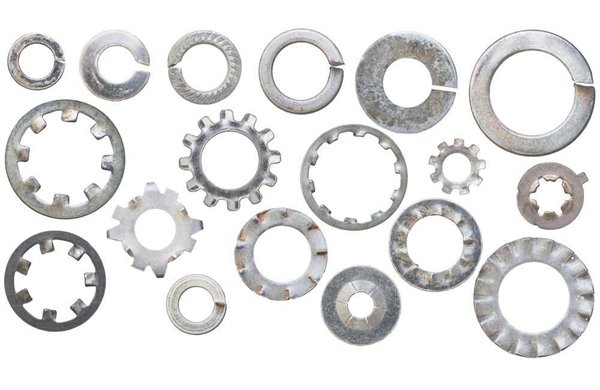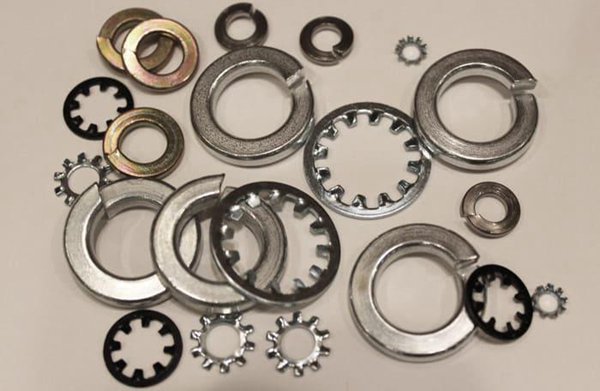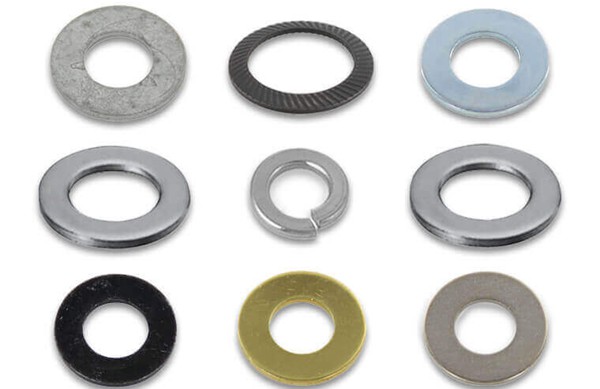Washers, small yet critical elements in fastening assemblies, play a multifaceted role across numerous applications. Typically crafted from materials like carbon steel and stainless steel, these unassuming components serve not only as seals and spacers but also provide crucial liquid protection and dampen vibrations. This article delves into the diverse world of washers, exploring their various types, the materials that constitute them, and offering guidance on selecting the optimal washer to meet specific requirements. Join us as we unravel the significance of these fundamental parts.
Washers, characterized by their small, flat, typically circular shape with a central aperture, are manufactured from a variety of materials.
Spacing and Alignment
Washers serve a practical purpose as spacers in fastening applications. When a threaded fastener is used with a component whose thickness is less than the fastener's length, the excess portion of the fastener will extend beyond the back surface. For example, attempting to fully tighten a 3-inch bolt in a 2-inch thick material would result in a 1-inch protrusion. However, by placing a washer onto the bolt before it is threaded into the material, this protrusion can be avoided. The washer effectively acts as padding, limiting the depth the fastener can penetrate. Furthermore, washers can accommodate minor discrepancies in the spacing between various fasteners and parts, thereby ensuring correct alignment during assembly.
Load Distribution
Washers play a crucial role in distributing the clamping force of fasteners evenly across a larger surface area. By dispersing the pressure exerted by a nut or bolt, washers significantly reduce the likelihood of material deformation, damage, or even failure. For instance, directly tightening a screw into a more pliable material can lead to surface cracking; however, the use of washers minimizes this potential for damage.
Seal/Liquid Protection
Certain types of washers are specifically designed to prevent the ingress and egress of water and other liquids. These sealing washers are commonly employed in applications such as water pipelines and connectors to create a watertight seal. Typically constructed from flexible materials, these washers ensure a complete and tight seal against the surface of the connected object.
Vibration Absorption
Select washer designs offer the capability to absorb vibrations. Unlike their metallic counterparts, these vibration-dampening washers are primarily made from softer materials such as plastic, rubber, or urethane. These resilient materials exhibit superior vibration absorption properties compared to harder metals. Consequently, these washers help safeguard connected components from damage, particularly in scenarios where one of the parts joined by a threaded fastener experiences significant vibration.
Damage Prevention
By acting as a protective interface between the nut or bolt head and the fastened surface, washers prevent direct contact. This separation serves to preserve the integrity of the material and maintain the aesthetic appearance of the connected surfaces by mitigating marring, scratches, dents, and other forms of damage.
Corrosion Prevention
Fastening washers, especially those manufactured from corrosion-resistant materials, provide an additional layer of defense against rust and other forms of corrosion. This protective function is particularly vital in environments where prolonged exposure to moisture, harsh chemicals, or other corrosive elements could compromise the integrity of the fastening system.
Plain Washers
Plain washers are the most popular kind. They disperse force and safeguard the item that the screw or nut is attached to. It also helps the screw or nut fit properly into a large hole. Plain washers in this category include:
Torque Washer
The principal uses for these washers are in the woodworking industry. When a nut is tightened, the outside prongs of the washers feature square holes that prevent the accompanying bolt from spinning.
Flat washer
Flat washers have a hole in the center and are flat or disc-shaped. They are ideal for small head screws because they spread the weight across a wider surface.
Fender washer
Fender washers are bigger and have a tiny hole in the center. They can spread out the load across a broader region. These washers are primarily used in sheet metal manufacturing, automotive fenders, and plumbing industries.
Finishing or countersunk washer
Countersunk washers in this category often create a flush finish upon securing with a flat-head countersunk screw. This ability to catch countersunk fasteners is due to its sunken top.
Shoulder washer
Shoulder washer fasteners in this category come in various materials, including PTFE, fiberglass, metal, phenolic, and nylon. These shoulder-like shaped washers often serve as insulators for screws and wires.
C-washer
A C-washer resembles a flat washer, but the primary difference is the hole cut from its center to form a C-shape. One primary advantage of this type of washer is that it is possible to adjust, remove or modify it without removing the fastener.

Spring Washers
For machinery that vibrates vigorously while operating, spring washers are ideal. They move with vibrations, thus preventing them from being loose or unfastened because of their axial flexibility, consequently increasing the joint’s flexibility. There are different types of spring washers.
Belleville or Conical washer
These washers, often called conical spring washers, are employed to maintain tension during the assembly’s thermal expansion and contraction. They can support large weights while deflecting only slightly.
Dome spring washer
A dome washer is renowned for having a large load capacity with minimal deflection. They also absorb excessive vibrations and flatten the surface.
In addition, they have ground curves that create a load-bearing surface that is flatter. It can be used everywhere. A crescent spring washer would be useful, although flattening the surface is also necessary.
Wave spring washer
Wave spring washers are curved in two directions and are typically employed as cushions or spacers. They can support a moderate amount of weight and guard against excessive wear on the surface.
Finger spring washer
Made using carbon steel, finger spring steel washers comprise three curved flanges. They help lessen vibration, skidding wear, additional wear, dampening, and noise on rotating parts.
Carbon steel is commonly used to make finger spring washers. They blend the wave washer’s predetermined load spots with the casing washer’s flexibility.
Crescent spring washer
The crescent spring washer, also called curved spring washer, has a somewhat curved appearance that gives them a lighter pressure while maintaining flexibility. They have an extensive deflection range and can withstand extremely light loads.
These washers have linear load-deflection characteristics and offer uniform spring rates throughout the deflection range.

Lock Washers
Lock washers are designed to help prevent the screws and nuts from rotating toward their loosening position. Consequently, this preserves them even during intense vibrations produced by the machine or equipment’s operation. In other words, they hold the fasteners that tend to loosen due to friction in place. The different types of lock washers include:
Split lock washer
The split lock washer, commonly called a helical washer, is used to secure fasteners. They are non-continuous rings bent inward and outward in opposing directions. When this fastener is used to secure the bent, both ends of the bent flatten out and dig into the mating surface.
External tooth lock washer
External tooth lock washers employ a teeth-structural action to keep the nut or screw head from coming undone. They function better with screws that have a larger head. The numerous teeth on their outer diameter bite into the surface to produce exceptional compression resistance, consequently ensuring they provide the highest level of torsional resistance.
Internal tooth lock washer
On the inside diameter of the internal tooth locker are many teeth that prevent the bolt or nut head from loosening. They serve to dampen noise and shock while locking shallow-head fasteners into position.
Specialized Washers
Specialized washers do not fall expressly into any of the above categories. Here is their information.
Keps nut
Also referred to as K-lock nuts, these washers with built-in washers facilitate spinning. The assembly functions more efficiently, thanks to the nuts.
Top hat washers
These washers are perfect to utilize while repairing or installing a tap because they are typically used in plumbing applications.
Keyed washers
Typically used between bolts to prevent them from spinning, these washers are placed keyed washers typically find application in the automotive industry. These washers have an internal tab that prevents the automobile shaft from rotating. They also find use in chassis parts and cylinder heads.
Insulating shoulder washer
Insulating shoulder washers are often made from nylon, peek, plastic, and other insulating materials. The best use for these washers is in the electrical sector, where they help isolate mounting screws from electrical current.
Gaskets
Gaskets, also known as O-rings, and made of rubber, come in different shapes and sizes depending on the purpose. It is a mechanical seal that fills the space between two or more surfaces in contact to prevent leaks and spills. In the automotive sector, their primary use is to slam shut oil and gas connectors and stop leaks.
Aside from rubber, gaskets can be made from light metals, such as aluminum, and other metals. These washers maintain a tight seal regardless of pressure and temperature, preventing gases and liquids from escaping.
Machinists use two major washer size standards; SAE washers and USS flat washers. The SAE washers are usually thinner and smaller than the USS washers. Below is a washer types chart of both washer categories.
| SAE FLAT WASHERS | |||
| Size | Inside Diameter | Outside Diameter | Thickness |
| #6 | 5/32″ | 3/8″ | 3/64″ |
| #8 | 3/16″ | 7/16″ | 3/64″ |
| #10 | 7/32″ | 1/2″ | 3/64″ |
| 1/4 | 9/32″ | 5/8″ | 1/16″ |
| 5/16 | 11/32″ | 11/16″ | 1/16″ |
| 3/8 | 13/32″ | 13/16″ | 1/16″ |
| 7/16 | 15/32″ | 59/64″ | 1/16″ |
| 1/2 | 17/32″ | 1-1/16″ | 3/32″ |
| 9/16 | 19/32″ | 1-3/16″ | 3/32″ |
| 5/8 | 21/32″ | 1-5/16″ | 3/32″ |
| 3/4 | 13/16″ | 1-1/2″ | 9/64″ |
| 7/8 | 15/16″ | 1-3/4″ | 9/64″ |
| 1″ | 1-1/16″ | 2″ | 9/64″ |
| 1-1/8 | 1-3/16″ | 2-1/4″ | 9/64″ |
| 1-1/4 | 1-5/16″ | 2-1/2″ | 5/32″ |
| 1-1/2 | 1-7/16″ | 3″ | 3/16″ |
| USS FLAT WASHERS | |||
| Size | Inside Diameter | Outside Diameter | Thickness |
| 3/16 | 1/4″ | 9/16″ | 3/64″ |
| 1/4 | 5/16″ | 3/4″ | 1/16″ |
| 5/16 | 3/8″ | 7/8″ | 5/64″ |
| 3/8 | 7/16″ | 1″ | 5/64″ |
| 7/16 | 1/2″ | 1-1/4″ | 5/64″ |
| 1/2 | 9/16″ | 1-3/8″ | 7/64″ |
| 9/16 | 5/8″ | 1-1/2″ | 7/64″ |
| 5/8 | 11/16″ | 1-3/4″ | 9/64″ |
| 3/4 | 13/16″ | 2″ | 5/32″ |
| 7/8 | 15/16″ | 2-1/4″ | 11/64″ |
| 1″ | 1-1/16″ | 2-1/2″ | 11/64″ |
| 1-1/8 | 1-1/4″ | 2-3/4″ | 11/64″ |
| 1-1/4 | 1-3/8″ | 3″ | 11/64″ |
| 1-3/8 | 1-1/2″ | 3-1/4″ | 3/16″ |
| 1-1/2 | 1-5/8″ | 3-1/2″ | 3/16″ |
| 1-5/8 | 1-3/4″ | 3-3/4″ | 3/16″ |
| 1-3/4 | 1-7/8″ | 4″ | 3/16″ |
| 1-7/8 | 2″ | 4-1/4″ | 3/16″ |
| 2″ | 2-1/8″ | 4-1/2″ | 3/16″ |
| 2-1/2 | 2-5/8″ | 5″ | 15/64″ |
| 3″ | 3-1/8″ | 5-1/2″ | 9/32″ |
Washers are manufactured in a variety of shapes, largely dictated by their specific function.
Spherical Shape: These washers are characterized by a precisely parallel plane between the bolt head and the nut face.
Square Shape: In comparison to round washers, square washers offer a larger surface area, which enhances torque distribution during fastening. They also provide improved resistance to corrosion and help prevent rotation of the fastener. Furthermore, square washers are utilized in seismic applications to mitigate electrical current, vibration, and sound transmission.
Shoulder Shape: Often referred to as insulator washers, these are typically non-metallic, frequently made from nylon.
Wave Shape: Typically constructed from metallic materials, wave washers exhibit a curved profile in two directions.
C-Shaped: Designed for easy lateral insertion and removal from a bolt without requiring the loosening of the nut, C-washers are primarily used as retention devices on grooved shafts. They serve to securely hold components in their designated positions. Examples of C-shaped washers include lock washers and slotted washers.

Here are some key standards to be aware of:
ASME ANSI B18.22.1 Plain Washers: This standard outlines the specifications for commonly used inch series flat washers. These washers feature a bearing surface and are designed for use under the heads of bolts or similar externally threaded fasteners to distribute the load. The material for these flat washers is typically specified under the ASTM F844 standard.
ASME B18.21.1 Helical Spring-Lock Washers: This standard covers inch series spring lock washers, which are available in standard, heavy, extra-duty, and high-collar configurations. These washers are commonly manufactured from materials such as stainless steel, 65Mn or #70 steel, or spring steel. In general applications, spring lock washers help distribute the load over a wider area for certain head designs and provide a hardened bearing surface to compensate for any loosening that may occur between the components of an assembly.
DIN 125A Flat Washers: The DIN 125A specification details the requirements for flat washers made from sheet metal. These washers possess a smooth bearing surface and are intended for placement under the heads of both nuts and bolts. Common materials for DIN 125A flat washers include stainless steel and carbon steel.
DIN 6799 Retaining Washers: DIN 6799 retaining washers, often referred to as E-Rings, are a type of high-performance washer made from spring steel or stainless steel. They are designed for use with eccentric shafts that have grooves for spring retention and are suitable for transmitting axial forces to secure components.
We look forward to building or deepening our partnership with you!
Meet a few members of our dedicated team, ready to help you:
Coco Chen, Director of Business Development: coco.chen@zjzrap.com
Freddie Xiao, Account Manager: freddie.xiao@zjzrap.com
Brian Xu, Technical Sales Assistant: brian.xu@zjzrap.com
Explore our capabilities and comprehensive product range: https://www.zjzrqc.com/product/

 English
English 中文简体
中文简体

